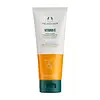What's inside
What's inside
 Key Ingredients
Key Ingredients

 Benefits
Benefits

 Concerns
Concerns

 Ingredients Side-by-side
Ingredients Side-by-side

Water
Skin ConditioningCoco-Glucoside
CleansingGlycerin
HumectantCocamidopropyl Betaine
CleansingPerlite
AbsorbentAcrylates/C10-30 Alkyl Acrylate Crosspolymer
Emulsion StabilisingPhenoxyethanol
PreservativeXanthan Gum
EmulsifyingCaprylyl Glycol
EmollientSodium Chloride
MaskingJojoba Esters
EmollientParfum
MaskingSodium Citrate
BufferingSodium Gluconate
Skin ConditioningLimonene
PerfumingSodium Hydroxide
Buffering3-O-Ethyl Ascorbic Acid
Skin ConditioningTrisodium Ethylenediamine Disuccinate
Benzyl Salicylate
PerfumingMyrciaria Dubia Fruit Extract
Skin ConditioningLinalool
PerfumingBenzyl Alcohol
PerfumingAloe Barbadensis Leaf Juice Powder
Skin ConditioningCitric Acid
BufferingTalc
AbrasiveCI 73360
Cosmetic ColorantCI 77492
Cosmetic ColorantWater, Coco-Glucoside, Glycerin, Cocamidopropyl Betaine, Perlite, Acrylates/C10-30 Alkyl Acrylate Crosspolymer, Phenoxyethanol, Xanthan Gum, Caprylyl Glycol, Sodium Chloride, Jojoba Esters, Parfum, Sodium Citrate, Sodium Gluconate, Limonene, Sodium Hydroxide, 3-O-Ethyl Ascorbic Acid, Trisodium Ethylenediamine Disuccinate, Benzyl Salicylate, Myrciaria Dubia Fruit Extract, Linalool, Benzyl Alcohol, Aloe Barbadensis Leaf Juice Powder, Citric Acid, Talc, CI 73360, CI 77492
Water
Skin ConditioningSodium Cocoyl Glycinate
CleansingGlycerin
HumectantAcrylates Copolymer
Perlite
AbsorbentSodium Chloride
MaskingPhenoxyethanol
PreservativeSodium Hydroxide
BufferingChlorphenesin
AntimicrobialSalicylic Acid
MaskingHydroxypropyl Tetrahydropyrantriol
Skin ConditioningPropylene Glycol
HumectantLavandula Angustifolia Oil
MaskingDisodium EDTA
Linalool
PerfumingButylene Glycol
HumectantCitrus Aurantium Tachibana Peel Extract
HumectantPaeonia Suffruticosa Root Extract
Skin ProtectingCitric Acid
BufferingWater, Sodium Cocoyl Glycinate, Glycerin, Acrylates Copolymer, Perlite, Sodium Chloride, Phenoxyethanol, Sodium Hydroxide, Chlorphenesin, Salicylic Acid, Hydroxypropyl Tetrahydropyrantriol, Propylene Glycol, Lavandula Angustifolia Oil, Disodium EDTA, Linalool, Butylene Glycol, Citrus Aurantium Tachibana Peel Extract, Paeonia Suffruticosa Root Extract, Citric Acid
Ingredients Explained
These ingredients are found in both products.
Ingredients higher up in an ingredient list are typically present in a larger amount.
Citric Acid is an alpha hydroxy acid (AHA) naturally found in citrus fruits like oranges, lemons, and limes.
Like other AHAs, citric acid can exfoliate skin by breaking down the bonds that hold dead skin cells together. This helps reveal smoother and brighter skin underneath.
However, this exfoliating effect only happens at high concentrations (20%) which can be hard to find in cosmetic products.
Due to this, citric acid is usually included in small amounts as a pH adjuster. This helps keep products slightly more acidic and compatible with skin's natural pH.
In skincare formulas, citric acid can:
While it can provide some skin benefits, research shows lactic acid and glycolic acid are generally more effective and less irritating exfoliants.
Most citric acid used in skincare today is made by fermenting sugars (usually from molasses). This synthetic version is identical to the natural citrus form but easier to stabilize and use in formulations.
Read more about some other popular AHA's here:
Learn more about Citric AcidGlycerin is already naturally found in your skin. It helps moisturize and protect your skin.
A study from 2016 found glycerin to be more effective as a humectant than AHAs and hyaluronic acid.
As a humectant, it helps the skin stay hydrated by pulling moisture to your skin. The low molecular weight of glycerin allows it to pull moisture into the deeper layers of your skin.
Hydrated skin improves your skin barrier; Your skin barrier helps protect against irritants and bacteria.
Glycerin has also been found to have antimicrobial and antiviral properties. Due to these properties, glycerin is often used in wound and burn treatments.
In cosmetics, glycerin is usually derived from plants such as soybean or palm. However, it can also be sourced from animals, such as tallow or animal fat.
This ingredient is organic, colorless, odorless, and non-toxic.
Glycerin is the name for this ingredient in American English. British English uses Glycerol/Glycerine.
Learn more about GlycerinLinalool is a fragrance and helps add scent to products. It's derived from common plants such as cinnamon, mint, citrus, and lavender.
Like Limonene, this ingredient oxidizes when exposed to air. Oxidized linalool can cause allergies and skin sensitivity.
This ingredient has a scent that is floral, spicy tropical, and citrus-like.
Learn more about LinaloolWe don't have a description for Perlite yet.
Phenoxyethanol is a preservative that has germicide, antimicrobial, and aromatic properties. Studies show that phenoxyethanol can prevent microbial growth. By itself, it has a scent that is similar to that of a rose.
It's often used in formulations along with Caprylyl Glycol to preserve the shelf life of products.
Chances are, you eat sodium chloride every day. Sodium Chloride is also known as table salt.
This ingredient has many purposes in skincare: thickener, emulsifier, and exfoliator.
You'll most likely find this ingredient in cleansers where it is used to create a gel-like texture. As an emulsifier, it also prevents ingredients from separating.
There is much debate on whether this ingredient is comedogenic. The short answer - comedogenic ratings don't tell the whole story. Learn more about comegodenic ratings here.
The concensus about this ingredient causing acne seems to be divided. Research is needed to understand if this ingredient does cause acne.
Scrubs may use salt as the primary exfoliating ingredient.
Learn more about Sodium ChlorideSodium Hydroxide is also known as lye or caustic soda. It is used to adjust the pH of products; many ingredients require a specific pH to be effective.
In small amounts, sodium hydroxide is considered safe to use. However, large amounts may cause chemical burns due to its high alkaline.
Your skin has a natural pH and acid mantle. This acid mantle helps prevent harmful bacteria from breaking through. The acid mantle also helps keep your skin hydrated.
"Alkaline" refers to a high pH level. A low pH level would be considered acidic.
Learn more about Sodium HydroxideWater. It's the most common cosmetic ingredient of all. You'll usually see it at the top of ingredient lists, meaning that it makes up the largest part of the product.
So why is it so popular? Water most often acts as a solvent - this means that it helps dissolve other ingredients into the formulation.
You'll also recognize water as that liquid we all need to stay alive. If you see this, drink a glass of water. Stay hydrated!
Learn more about Water